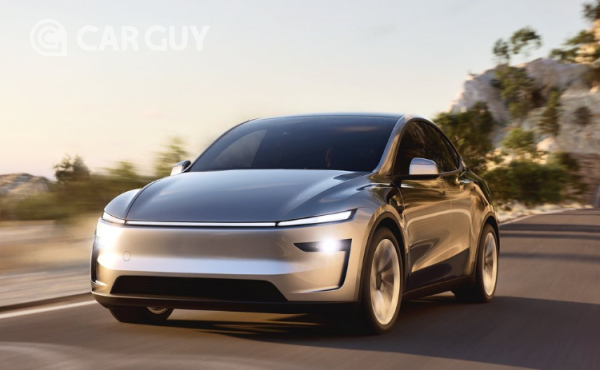Driving safely is more important than cutting-edge..Best 6 with the right physical button
May 27, 2025
|
However, many consumers complained of inconvenience in the new way. Eventually, the turn signal lever was re-applied to the new Model Y. In line with this trend, many car brands besides Tesla are reducing or deleting the number of physical buttons. In particular, this trend is gradually strengthening due to the expansion of autonomous driving and wireless update (OTA).
But it is true that physical buttons are more intuitive and easier to operate while driving at the moment.In the North American auto market, where touch screens are increasingly mainstream, six vehicles with satisfactory physical buttons and levers were selected from the auto blog.
The first vehicle is the Mazda CX50. This vehicle applies buttons, handles, and switches well to the right place, so you don't want to use the touchscreen. Car buyers are increasingly criticized for deleting physical buttons, prompting the return of essential physical control buttons in the European New Vehicle Safety Assessment Test (NCAP).
In today's automotive market, usability and safety are often sacrificed as large touch screens and digital interfaces dominate the indoor experience.These functions also have clear advantages that allow advanced aesthetics and various advanced functions to be used virtually.
However, the time it takes to perform basic operations such as air conditioning or audio control is also prolonged and sometimes there is a risk of collision. Fortunately, some automakers still understand the value of intuitive physical devices, such as dials, knobs, and buttons, placed where the driver can easily operate.
The Mazda CX-50 offers one of the most attractive and driver-centric interiors in the industry.Mazda insists on excellent physical control methods even in the latest vehicles. After all, the core of the brand is still a safe driving experience.
While many automakers are moving to tablet-style screens and capacitive buttons, Mazda has maintained a rotating infotainment controller and a smart, well-organized dashboard layout, sticking to standards for usability.The CX-50 is the most splendid interior space among Mazda vehicles.
The physical control is almost incomparable and stands out the most. CX-50 is a good example of how physical control can improve the driving experience. In particular, the rotary commander controller is located in the center console between the front seats, so that you can manipulate menus without touching the screen.
Despite its excellent sense of operation, Mazda tends not to use touch screens so that it can focus on the road while driving.The knob is knurled to an appropriate size for easy grip and operation.Right next to it is a convenient audio knob.
The second vehicle is the Hyundai Kona. The newly designed 2025 Kona bears little resemblance to its predecessor.The second-generation model has taken a huge leap forward in style and technology, but it still retains its emphasis on tactile manipulation while boasting a much better look.
Even in the upper trim equipped with a dual 12.3-inch screen, Hyundai has balanced digital and excellent analog manipulation. It provides indoor space for drivers of all ages and technical convenience levels.The center stack is filled with neat knobs and buttons.The same goes for the center console.
In a way, it can be seen as superior to the interior of Tucson, which is one grade above.Kona's success lies in not overwhelming the driver with unnecessary complexity.It provides enough buttons to perform intuitive operations without feeling cluttered. A panel composed of actual buttons can control temperature, air volume, and fan speed separately from the infotainment system.
Kona's air conditioning button is simple. It's easy to reach, and it's not a hassle. Clean audio control lines are arranged perfectly spaced over the air conditioning system panel.Curved buttons and backlight knobs provide quick control of audio functions. It is as functional as the design.
Hyundai uses column-type levers for gear shifting. Although it does not move up and down like other models, it can be operated by turning a large rectangular shape with a groove forward, backward, or parking. It is much better than most column type shift levers.
The third vehicle is the 2025 Toyota Grand Highlander.We continue to admire the interior of the Grand Highlander, not only because of its space and comfort, but also because it has the best physical controls for a seven-seater family SUV.The Grand Highlander is not only a larger version of the popular semi-large SUV Highlander, but also an impressive third-row SUV with its thoughtful design and practical features.
In fact, the physical controls are significantly better than the regular highlander.The upper trim has a huge 12.3-inch touchscreen. Toyota wisely connects the most essential functions to physical controls, providing satisfactory results for drivers.
Toyota's approach is simple.It is intended to make the technology available but not to interfere with the operation of the core vehicle. The central thermostat is 100% physically operated.
The thermostatic knob was placed next to the heating/ventilation button instead of being hidden behind the touchscreen menu.Additional temperature control buttons and toggles on the panel make it easier to adjust.
The fourth vehicle is the 2025 Toyota Rav4. The 2025 Toyota Lab4 will come out with a full-change model this year, but the current model also shows the essence of ergonomic excellence.
Having established itself as one of the best-selling vehicles in the U.S., the Raab 4 boasts interior space with the best physical manipulation of all crossover models, regardless of price point.
The large, textured handle has a built-in temperature display window, making it easy to operate even with gloves on.Its large, protruding design makes it convenient to hold in your hand.The set temperature is displayed right next to the handle, and there is a warm and cold status indication line for easy confirmation.
I also like that the transmission doesn't have a shift button.Toyota uses a moderately sized physical shift knob that is not too blunt or too high.
The fifth vehicle, the sixth-generation Honda CR-V, is a nice looking hybrid. The new CR-V interior design can be evaluated as the best-in-class.
The interior creates an analog feeling. Screen-based features and physical switches are ideally harmonized.It is regrettable that the infotainment system is better, but the physical manipulation button shines.
An actual handle and push button neatly placed under the central honeycomb pattern vent control the air conditioning system.The three handles, which are adequate in size and spaced, control the temperature and fan speed.On the left side of the infotainment screen frame, physical audio controls such as volume knobs, tuning buttons, home and back buttons make it easy to operate.
The CR-V is equipped with a true PRND shift lever. It is much more intuitive than other Honda SUV push buttons. You don't even need to look at the lever for shifting. I like it because it's really simple.
The sixth vehicle is the 2025 Ford Maverick. Who would have imagined that Ford would revive the old name of small cars in the 70s and transform them into popular small pickup trucks. The 2025 Maverick has expanded its existing 8-inch infotainment screen to a much larger 13.2-inch version, but it still uses great knobs and buttons to control air conditioning and audio.
Whether you're transporting wood or driving through the city center, Maverick's physical manipulator allows you to focus on your work without fiddling with the screen or menu. The two large air conditioning knobs are key.One for fan speed control and the other for temperature control.It has a built-in simple confirmation function inside.
Just below the infotainment screen is a great audio control manipulation.There are knobs and buttons for quick audio control. It is much more convenient to operate by tilting upward toward the driver. Some may criticize the traditional shift knob, but Maverick's rotary version is one of the best.
The easy-to-operate trim and satisfactory click sound allow you to change intuitively without looking at the gear.In an era of accelerating digitization, physical control devices offer tactile and intensive alternatives to fully touchscreen-based indoor spaces.
Matsuda CX-50, Hyundai Kona, Toyota Grand Highlander, Toyota RAV4, Honda CR-V, and Ford Maverick show that automakers can, and should, balance innovation and usability.
These six vehicles demonstrate that physical controls still play an essential role in making driving safer, easier, and more enjoyable.
Editor Song Moon-cheol mc.song@carguy.kr
This article was translated by Naver AI translator.














